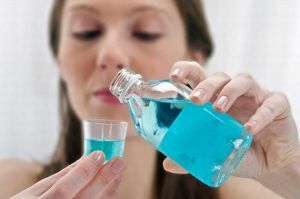 The rinse aid is an antiseptic liquid used to clean the mouth of microbes.
The rinse aid is an antiseptic liquid used to clean the mouth of microbes.
The product will help to keep your teeth healthy by performing a therapeutic and hygienic function. But only a few know how to properly use it and for what purpose it is used.
Contents
- Usage goals
- history
- development history
- efficiency issue Therapeutic and cosmetic effect
- Top ten tools
- folk conditioner How to use the
- tool From the practical experience of using
The purposes of using
Earlier rinse used only as deodorizing balm, so in itsThe composition was always melissa, mint, lavender and other herbs.
But with the advent of chewing gum, the rinse was started to be produced as a curative and preventive agent.
The main purposes of use are:
- Breath freshness .Compared to toothpaste, this solution has a longer lasting effect.
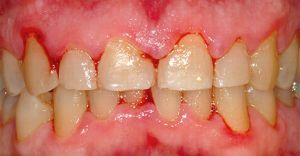
- Cleansing the mouth .Will allow to remove the leftovers of food and harmful bacteria. Especially this method is relevant for those who wear braces.
- Prevention of diseases .Balm helps prevent some dental problems, such as tooth decay, tooth sensitivity and bleeding gums .
- Whitening .Not all drugs have this property, so you should first examine the packaging of the product.
History of the
Creation For the first time, rinsers for the mouth, gums and teeth are mentioned in 2700 BC.in Chinese and Ayurvedic medicine.
A little later to rinse the mouth with a special remedy started in Greece and Rome. At that time, Hippocrates advised using a mixture of vinegar, alum and salt for this purpose. Before the appearance of Europeans on American soil, the Aborigines made balm from different plants and herbs.
In the 17th century microscopist Anton van Leeuwenhoek found living organisms in dental deposits, which are now known as plaque. After that, he began experimenting, adding brandy and vinegar to the samples.
The first conditioner went on sale in the USA in 1895 under the name Listerine, but it was intended only for dentists.
It was possible to buy it in pharmacies in 1914.
In 1892 in Europe Carl August Lingner introduced the market to his products - Odol.
Danish professor Harald Loe in the late 1960s proved that Chlorhexidine is able to prevent the occurrence of plaque. Since that time, the rinsers began to sell more actively, because some manufacturers said that their product will also reduce the manifestations of gingivitis and an unpleasant odor from the mouth.
Till now Listerine occupies a leading position in the market for the production of dentifrices.
On the question of the effectiveness of
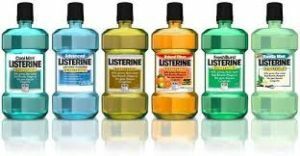 Specialists in the field of dentistry are still arguing about how effective this product is. Most of them assure that the effectiveness of the balm for rinsing the oral cavity depends on its kind.
Specialists in the field of dentistry are still arguing about how effective this product is. Most of them assure that the effectiveness of the balm for rinsing the oral cavity depends on its kind.
Doctors came to the mutual opinion that rinsers with fluoride contribute to reducing the number of bacteria that cause caries and bad breath. But some drugs leave stains on the tooth enamel.
It has long been proven by scientists that anti-caries drugs can cope well with bacteria, and hygienic drugs do not allow the formation of a plaque. Therefore, dentists recommend brushing your teeth twice a day, then use a rinse aid.
Therapeutic and cosmetic effect
Depending on the type of the product, the use of a rinse aid solves the following tasks:
- Some rinse aid is only for use with the hygienic purpose of the .They will help get rid of the leftovers in the oral cavity and reduce the number of bacteria.
- Freshness of will be enhanced by such additional components as menthol or mint. This will remove bad breath from the mouth only for a short time, because they only mask the problem, and do not treat.
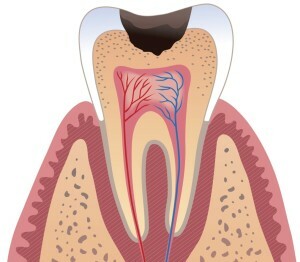
- Therapeutic balsams are manufactured specifically for dealing with dental problems. Anti-caries preparation contains calcium, fluoride and helps to strengthen tooth enamel, preventing the appearance of carious deposits. With inflammatory diseases of the gums will cope with antibacterial rinsers, which include active elements that slow the spread of streptococci and staphylococci.
- Balms, designed by for the control of tartar , have calcium citrate in their composition. The remedy will become indispensable for those who suffer from periodontitis, stomatitis and gingivitis.
Top ten tools
Based on the reviews from numerous reviews, one can distinguish such TOP-10 best mouthwashes:
- Lacalut aktiv .German rinse aid consists of chlorhexidine, sodium fluoride, aluminum lactate. There is no ethyl alcohol in the composition. The product effectively fights with bleeding, inflammation of the gums and caries. It has a pleasant taste and smell, but it is not recommended to use it for longer than 21 days.
- Listerine .The composition of the Italian origin is sodium chloride, alcohol, methyl salicylate, thymol and eucalyptus extract. The drug effectively fights harmful bacteria and is used to prevent plaque, gingivitis and bad breath from the mouth. With periodontal disease and gum diseases, it is used in complex treatment for two weeks.
- Mexidol .Rinser for the mouth is made in Russia. It contains mexidol, amino acids, alcohol and licorice root extract. It is used periodically and is prescribed to people prone to developing stomatitis and other inflammatory processes.
- Splat complete .The Russian preparation consists of a polydon, an extract of leaves of a nettle and biosol. The rinse aid prevents the appearance of plaque on the teeth and has an antibacterial effect. Suitable for long-term use.
- Elmex .The composition of the rinse aid from Colgate includes sodium fluoride and aminofluoride. The components contribute to the penetration of fluoride into the tooth enamel for a long time. Use the product is allowed from the age of six because of the lack of alcohol and antiseptics in it.
- President .Rinser is made in Italy, the main components of which are xylitol, sodium fluoride and components on a plant basis. Balm has a refreshing effect and protects tooth enamel from carious lesions. In its composition there is no alcohol, so the liquid is allowed to be used by children from 6 years of age.
- Parodontax .The mouthwash from the UK contains alcohol, chlorhexidine bigluconate, sodium chloride and eugenol. Promotes the removal of plaque and fights inflammatory processes of the gums. The maximum period of application is a month.
- Glister .Rinser, made in Germany, contains cetylpyridinium chloride and alcohol. The drug is recommended for periodontal inflammation without ulcers and wounds, as well as with an unpleasant odor from the oral cavity. Do not use it for more than two weeks.
- Asepta .The mouthwash of Russian production consists of xylitol, benzidamine and chlorhexidine bigluconate. It has analgesic and anti-inflammatory properties. It is used for inflammatory diseases of the gums. It is not recommended to use the drug for more than 14 days, otherwise there is a risk of dysbacteriosis of the oral cavity.
- Wood balm .A remedy from the Russian concern "Kalina" is produced in 12 different types. Not all have natural ingredients in the composition, some have triclosan, fragrances and organic solvents.
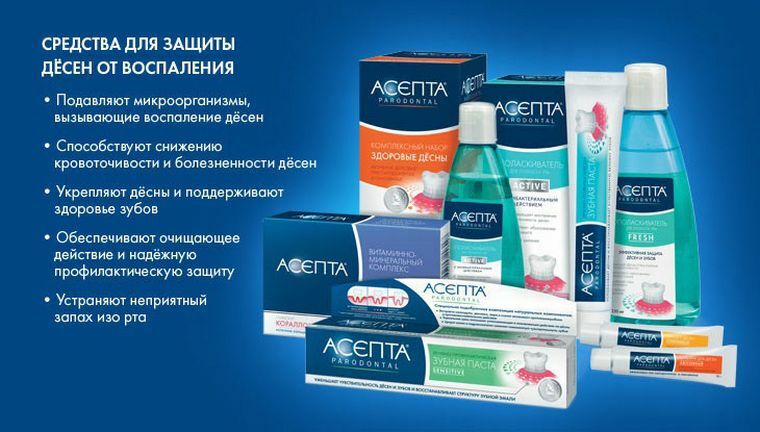
Popular rinse aid
Many people prefer to use a rinse aid made at home. The main advantage of this product is an absolutely natural composition without chemical preservatives and colorants.
Here is the recipe of one of the most popular folk remedies with anti-inflammatory effect:
- bark of oak ( 2 tbsp.) Is poured with a glass of steep boiling water, and put on a steam bath for half an hour;
- leaves of nut( 2 tablespoons) are also poured with boiled hot water, and then sent to the steam bath for 10 minutes;
- infusion of sage and peppermint is also done, but a steam bath is not required, it is insisted for 40 minutes.
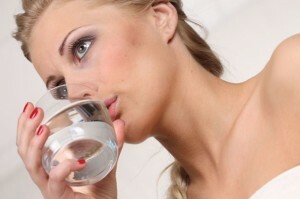 After cooking the broths, they need to be drained in one container and add a few drops of aloe juice.
After cooking the broths, they need to be drained in one container and add a few drops of aloe juice.
To keep the product for longer, you need to pour 1 tbsp.soda.
At the end, 5 drops of eucalyptus and essential oils are added. The product is stored in the refrigerator, but not more than 3 weeks.
How to correctly use the tool
Many people make mistakes, perceiving the rinse aid as a full-fledged substitute for toothpaste. This is not so, but in emergency cases, you can apply this method. Rinse your mouth with a remedy twice a day: morning and evening.
The procedure is carried out after cleaning the teeth and for one time 10-20 ml of the drug is enough.
The oral cavity rinses for 30 seconds, the composition is not swallowed, but is spit out. To rinse the best effect, it is recommended that you do not consume anything for an hour.
From the practical experience of using
From the feedback of consumers who use mouthwashes for oral hygiene.
I have been suffering from hypersensitivity for a long time, so I often have to go to the dentist. My doctor recommended using a Splat rinse. After a few applications, I see the result and now I do not react so much to cold and hot food.
Sergey, 34
I sometimes get an unpleasant smell from my mouth, and I was saved by chewing gums, until I tried Listerine. Now the problem has practically disappeared, and I can live normally.
Valery, 43
Stomatitis worries me since childhood, having tried different elixirs, decoctions, vitamins, I chose the Lacalut mouthwash. Taste, smell, and the price suits me completely.
Alina, 28
Before starting regular mouthwash, consult your dentist. Only a professional will help to choose the most effective means, based on individual patient problems.
In complex care, the mouth rinse balm will help restore a healthy smile, as well as forget about stomatitis, bleeding gums and plaque.
